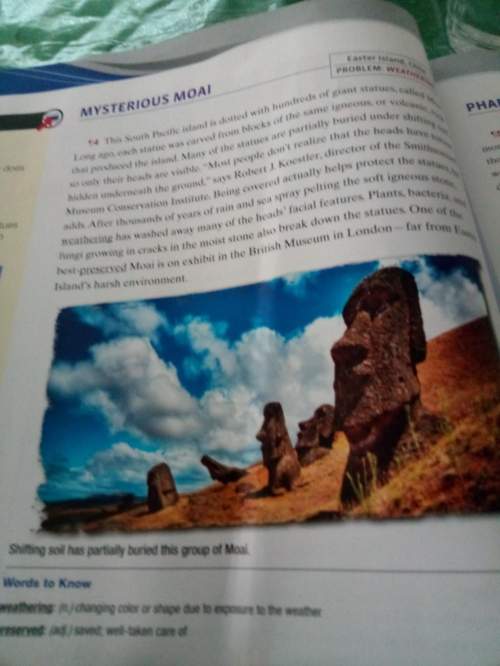The Mystery of Loch Ness
By Kayden Mitchell
Of all the mysteries in the world, none has...

English, 08.10.2021 01:40 jprofaci29
The Mystery of Loch Ness
By Kayden Mitchell
Of all the mysteries in the world, none has been as popular as that of the Loch Ness Monster. Perhaps the biggest mystery is whether it is convincing evidence or a simple desire to believe that keeps the myth alive.
Loch Ness is a lake in Scotland. The loch, or lake, is known for sightings of a mysterious monster. Most who see this monster, known as Nessie, describe something with a long neck and several humps above the water. Sometimes the "monster" is moving in these sightings, and sometimes it is still. Many have suggested that Nessie might be a plesiosaur (plea-see-a-soar), an aquatic dinosaur that was trapped in the loch after the last ice age.
The plesiosaur theory presents several problems. First, the plesiosaur is an air breather. Such a creature would need to surface often and, therefore, be seen more frequently. Second, it's unlikely that the same creature has lived in the loch since the last ice age. Today's creature would have to be the offspring of an original plesiosaur trapped long ago. This would suggest multiple creatures in the loch (needed to produce offspring). Again, sightings would be more frequent if this were the case.
So from a purely logical stand point, the existence of such a large and ancient creature is unlikely. But assume for a minute that it is possible. What would a plesiosaur need to live in an enclosed lake?
Tropical waters: Scientists believe plesiosaurs were warm-blooded. Like crocodiles and alligators, plesiosaurs would need to live in warm waters. The loch is very cold with temperatures averaging about 40 degrees Fahrenheit (4.4 Celsius).
Food: Like other warm-blooded creatures, plesiosaurs would need a large quantity of food. If there is a group of Nessies, then even more food would be needed. Because the loch is full of silt (underwater dust) not much light gets into the deepest areas. So the food chain, which would depend on plankton, is very weak at its base. As a result, there is probably not enough food to support such a large creature.
However, the plesiosaur theory is not the only one. Many other ideas attempt to explain the sightings and "photographs." But two separate sonar surveys of the loch have not found any evidence of a creature larger than a salmon. The last survey,1 completed in 2007 by the British Broadcasting Company (BBC), involved 600 different sonar beams. Using satellite navigation systems, the team made sure every inch of the loch was searched. The team found nothing.
With cell phones and digital cameras, one would think that sightings of Nessie would increase. This has not happened. The BBC team believes the legend of Nessie has endured because people see what they want to see. To prove this, the team used a fence post, raising it before groups of tourists. Afterwards several of the tourists asked to draw pictures of what they had seen drew pictures of a monster's head.
1"BBC 'proves' Nessie does not exist." 27 July, 2003.
http://news. bbc. co. uk/2/hi/science/nature/3096839.stm< br />
What is the main idea of this passage?
A. Most tourists do not really know what they are seeing when they visit Loch Ness.
B. Sonar technology is the best way to solve most monster mysteries.
C. The most common theory and all other theories about Nessie are likely not true.
D. While many people can recreate what they have seen, some use their imaginations.
Help fasst

Answers: 3


Another question on English

English, 22.06.2019 01:50
To meet the needs of commuters in the industrial age, city planners implemented the use of phonographs. provided more horses and carriages. borrowed technology from railroads. constructed new telephone lines.
Answers: 1

English, 22.06.2019 10:00
Read the sentences. the lowest point in antarctica appears to be the bentley subglacial trench, which is 8,200 feet below sea level. lower points may exist. which choice correctly uses the subordinating conjunction “although” to combine the sentences? the lowest point in antarctica appears to be the bentley subglacial trench, which is 8,200 feet below sea level, although lower points may exist. the lowest point in antarctica appears to be the bentley subglacial trench, which is 8,200 feet below sea level. although lower points may exist. the lowest point in antarctica appears to be the bentley subglacial trench, which is 8,200 feet below sea level although, lower points may exist. the lowest point in antarctica appears to be the bentley subglacial trench, which is 8,200 feet below sea level; although lower points may exist.
Answers: 2


English, 23.06.2019 00:00
Which quotations from sojourner truth's speech “ain’t i a woman? ” are examples of fallacious reasoning? select each correct answer. "look at me! look at my arm! i have ploughed and planted, and gathered into barns, and no man could head me! and ain't i a woman? " "then they talk about this thing in the head; what's this they call it? [member of audience whispers, 'intellect'] that's it, honey. what's that got to do with women's rights or negroes' rights? " "i have borne thirteen children, and seen most all sold off to slavery, and when i cried out with my mother's grief, none but jesus heard me! " "that man over there says that women need to be into carriages, and lifted over ditches, and to have the best place everywhere. nobody ever me into carriages, or over mud-puddles, or gives me any best place! "
Answers: 3
You know the right answer?
Questions







Social Studies, 13.11.2019 09:31

Chemistry, 13.11.2019 09:31


History, 13.11.2019 09:31




Mathematics, 13.11.2019 09:31


Computers and Technology, 13.11.2019 09:31

English, 13.11.2019 09:31


Mathematics, 13.11.2019 09:31




